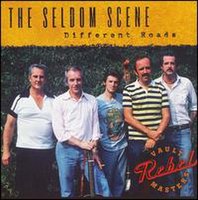The Seldom Scene
| The Seldom Scene | |
|---|---|

Original lineup of The Seldom Scene in 1973: John Duffey, Mike Auldridge, Tom Gray, Ben Eldridge, John Starling
|
|
| Background information | |
| Origin | Bethesda, Maryland, United States |
| Genres | Bluegrass, country, Progressive bluegrass |
| Years active | 1971–present |
| Labels | Rebel, Sugar Hill |
| Associated acts | Chesapeake, Country Gentlemen, Jonathan Edwards |
| Website | seldomscene |
| Members |
Ben Eldridge Lou Reid Dudley Connell Ronnie Simpkins Fred Travers |
| Past members |
John Duffey Mike Auldridge Tom Gray John Starling Phil Rosenthal T. Michael Coleman Moondi Klein |
The Seldom Scene is an American bluegrass band formed in 1971 in Bethesda, Maryland.
The band formed out of the weekly jam sessions in the basement of banjo player Ben Eldridge. These sessions included John Starling on guitar and lead vocals, Mike Auldridge on Dobro and baritone vocals, and Tom Gray on bass. Then mandolinist John Duffey, who had previously played with the Country Gentlemen, was invited to the jam sessions at the time when Auldridge arranged for the group to play as a performing band.
Each of the band members had a job during the week; Duffey repaired musical instruments, Eldridge was a mathematician, Starling a physician, Auldridge a graphic artist, and Gray a cartographer with National Geographic. They agreed to play one night a week at local clubs, perform occasionally at concerts and festivals on weekends, and make records. The band's first home scene was the Red Fox Inn in Bethesda, Maryland, where they spent six years before starting weekly performances at The Birchmere Music Hall in Alexandria, Virginia.
Bluegrass reached a second peak in popularity in the early 1970s, and the progressive bluegrass style played by The Seldom Scene was particularly popular, especially Duffey's high tenor and the vocal blend of Duffey/Starling/Auldridge. Their weekly shows included bluegrass versions of country music, rock, and even classical pop. The band's popularity soon forced them to play more than once a week —but they continued to maintain their image as being seldom seen, and on several of their early album covers were photographed with the stage lights on only their feet, or with their backs to the camera.
...
Wikipedia
